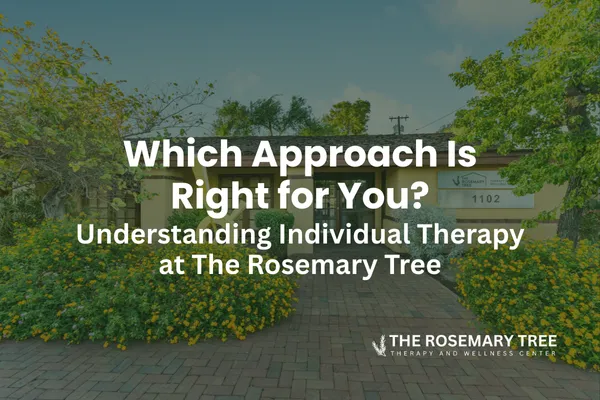
Understanding Individual Therapy at The Rosemary Tree: Which Approach Is Right for You?
When you’re considering therapy, the different terms can feel overwhelming. Narrative therapy, DBT, EMDR, IFS… it’s a long list. At The Rosemary Tree, we believe in making the process clear and accessible. Each therapy type is designed to meet people where they are and help them heal in different ways. Here’s a guide to the approaches we offer, so you can better understand which might be right for you.
Narrative Therapy
Narrative therapy helps clients “separate” themselves from their problems. It focuses on the stories we tell ourselves about our lives and reframing those narratives in ways that foster resilience, self-worth, and growth.
Best for: People who feel stuck in negative patterns or defined by past events.
Dialectical Behavior Therapy (DBT)
DBT is a skills-based therapy that combines mindfulness, acceptance, and behavior change. It teaches emotional regulation, distress tolerance, interpersonal effectiveness, and mindfulness strategies.
Best for: Individuals struggling with intense emotions, self-harm, or unstable relationships.
Eye Movement Desensitization and Reprocessing (EMDR)
EMDR is a trauma-focused therapy that helps people reprocess distressing memories using bilateral stimulation (such as guided eye movements). This reduces the emotional charge associated with trauma.
Best for: People experiencing PTSD, trauma, or anxiety linked to painful memories.
Internal Family Systems (IFS)
IFS sees the mind as made up of different “parts” (like the inner critic, the protector, the wounded child). Therapy helps those parts work together under the guidance of your “core self.”
Best for: Those who feel inner conflict or want deeper self-understanding.
Cognitive Behavioral Therapy (CBT)
CBT focuses on identifying and changing unhelpful thoughts and behaviors. It’s structured, practical, and often short-term.
Best for: Anxiety, depression, phobias, or anyone wanting tools to challenge negative thinking.
Acceptance and Commitment Therapy (ACT)
ACT combines mindfulness with values-based action. It teaches people to accept what they can’t control while committing to meaningful choices aligned with their values.
Best for: Individuals dealing with anxiety, chronic stress, or difficulty adjusting to life transitions.
Restoration Therapy (RT)
Restoration Therapy blends emotional regulation, attachment theory, and the “pain cycle vs. peace cycle” model. It helps people identify triggers, regulate their responses, and build healthier patterns.
Best for: Couples, individuals, or families navigating conflict and emotional wounds.
Sensorimotor Therapy
Sensorimotor therapy combines body awareness and talk therapy. By focusing on physical sensations, clients can process trauma that’s “stored” in the body.
Best for: Trauma survivors, or those experiencing dissociation or chronic stress.
Gestalt Therapy
Gestalt therapy emphasizes “here and now” awareness. It encourages people to focus on present feelings, thoughts, and behaviors, and how they interact with others.
Best for: Clients seeking greater self-awareness and personal responsibility.
Art Therapy
Art therapy uses creative expression (drawing, painting, sculpting) to help people process emotions, reduce stress, and gain insight. It is guided by a trained therapist and doesn’t require artistic skill.
Best for: Anyone who struggles to express themselves verbally or wants a creative path to healing.
How to Know What’s Right for You
Choosing the right therapy depends on your goals, symptoms, and personality. Many clients start with one approach and then integrate others as they progress. At The Rosemary Tree, our licensed therapists will help you decide which method—or combination of methods—best fits your journey.
Final Thoughts
Therapy isn’t one-size-fits-all. Whether you connect most with structured CBT, creative art therapy, or body-based sensorimotor work, there’s an approach designed to meet you where you are. If you’re ready to explore which path might help you, we’re here to walk with you.
